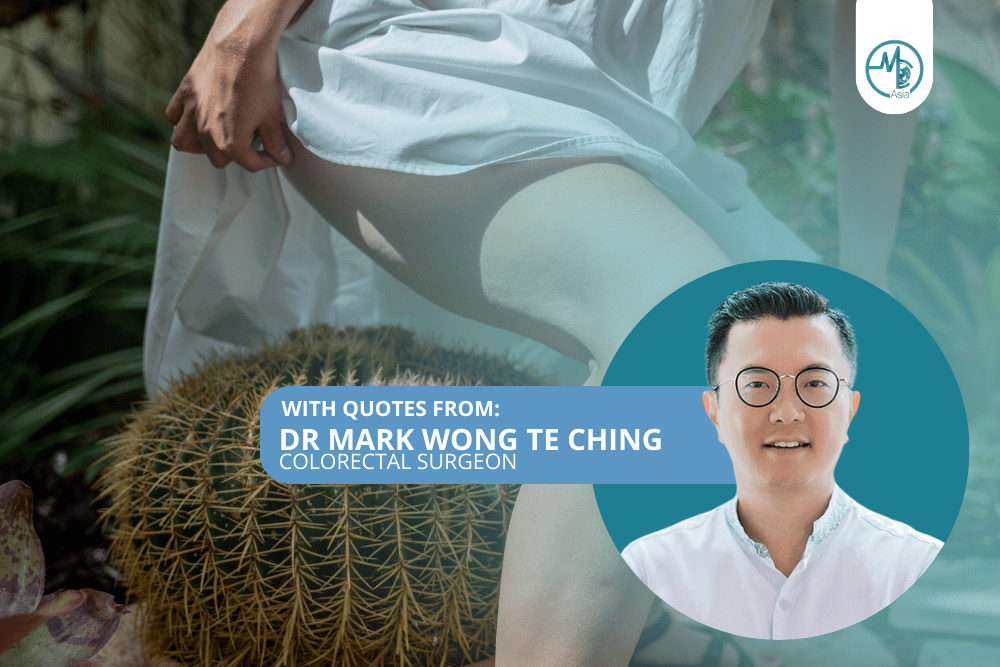In a hush-hush society where specific health topics seldom make headlines, haemorrhoids – those pesky, painful lumps – are coming out of the shadows.
Affecting roughly half the population by age 50, this prevalent condition is demanding attention, prompting experts and sufferers alike to shed light on its causes, symptoms, and much-needed remedies. We get insights from Dr Mark Wong Te Ching, Colorectal Surgeon at Mark Wong Surgery.
What Are Haemorrhoids?
Haemorrhoids, commonly known as piles, are blood vessels in the rectum or anus. When swollen, these uncomfortable lumps can be internal or external, leading to pain, itching, and bleeding.
The Big “Why?”
Various factors contribute:
Straining during bowel movements
Constipation is a common culprit. Excessive and prolonged straining; sitting on the toilet bowl for too long increases the risk of developing haemorrhoids.
Dr Wong added, “the common obsession and myth about needing to poop daily have led many people to sit and wait on the toilet bowl unnecessarily, spending a long time on excessive straining. When one sits on the bowl, one’s haemorrhoids will automatically swell.”
Pregnancy
Pregnancy can increase the risk of developing haemorrhoids because the foetus exerts more pressure on the veins in the mother’s pelvis, causing the haemorrhoids to swell, says Dr Wong. As the foetus grows, the risk heightens, especially during delivery when the mother strains and pushes. Thankfully, like leg swelling during pregnancy, these haemorrhoids typically shrink after the baby’s birth.
Ageing
As we age, tissues in the region weaken, making us prone—the risk factor increases.
Heavy lifting
Consistent lifting of heavy objects can raise pressure in the lower rectum. Dr Wong stated, “Any exercise that is repetitive and prolonged, especially those involving significant straining such as weights-associated or squatting type exercises, can cause our haemorrhoidal tissue to swell excessively. However, this is usually about other lifestyle factors, such as an unbalanced diet (too much fibre or meat) and spending too much time on the toilet bowl. Together, these factors can cause sustained damage to our piles.“
The Numbers Tell a Story
Approximately 50% of people will experience symptoms by age 50. That’s a significant chunk of the population!
Symptoms to Watch Out For
- Itching around the anus.
- Pain or discomfort.
- Swelling or a lump near the anus.
- Bleeding during bowel movements.
The Treatment Toolbox
Dr Wong urged “to seek treatment early and identify the triggering factors in your lifestyle, such as your diet, your toileting habits and your exercise routine. These actions, together with understanding and debunking the myths surrounding piles, are vital for the effective and long-term relief of symptoms.”
After identifying the causes and suggesting lifestyle changes, medication is usually prescribed.
Additionally, Dr Wong suggested that surgery is only sometimes recommended. He stated that “Haemorrhoids (or piles) are a normal part of our body, specifically the anus. Together with the anal muscles, they are part of our important continence mechanism – they help us to hold in our stools. As such, they should be left alone if they are not causing problems”
Prevention is Key
To reduce your risk:
- Stay hydrated.
- Consume a high-fibre diet.
- Avoid long periods of sitting.
- Use the toilet as soon as you feel the urge.
The Bottom Line
Haemorrhoids, while familiar, are treatable. Early detection and suitable lifestyle changes can make a world of difference. Remember, you’re not alone in this, and there’s no shame in seeking help.

